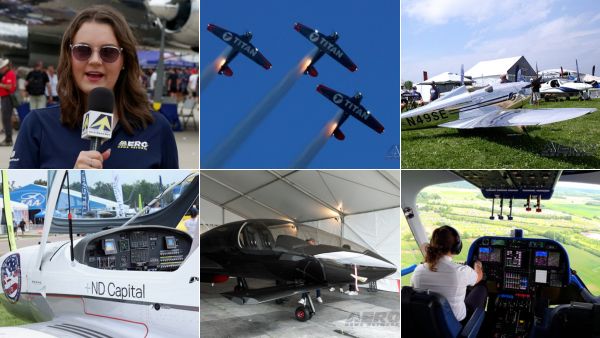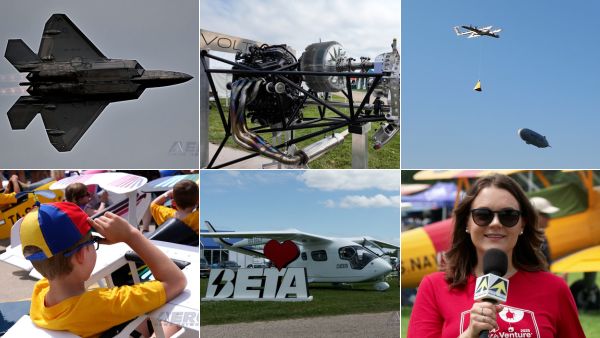Boeing 787 One of First to Benefit
The Goodrich brake unit for a Boeing 787 Dreamliner looks like
any other jet brake pack -- until you start looking for a place to
connect the hydraulic line. You can look as long as you like, but
there isn't one: the brake is electric.
Goodrich is one of two vendors whose brakes are available on the
Dreamliner; customers may opt for Messier-Bugatti brakes instead.
But either way, they'll be getting something new in airliners:
electric brakes.
In an electric brake, the toe brakes in the cockpit actuate a
pedal position and/or pressure controller, whose input feeds into
the master brake control, which sends a signal to the brake pack,
where electromechanical actuators (EAs) move the pads into contact
with the discs, turning energy into heat by means of friction, and
slowing the airplane.
So at a glance, the system simply substitutes electrical
components for the familiar master and slave cylinders used in a
hydraulic brake system. But not so fast, there, throttle jockey:
that does not take into account the advantages of electric
brakes.
Writing in SAE's Aerospace Engineering magazine (Aero-News: we
read this stuff so you don't have to), Goodrich's Leibert Danielson
enumerated the advantages of electric brakes, many of which come
about because of the high reliability, consistency and modularity
of modern electronics: reduced aircraft assembly time for the
manufacturer, improved reliability and reduced maintenance for the
operator, higher system redundancy for both reliability and safety.
"An added benefit is the elimination of brake fluid, with its leaks
and fire hazards," he writes.
The greatest benefit, as
Danielson says, is that "digital control sets up an infrastructure
for information gathering, health monitoring, and action..." or in
other words, an intelligent braking system.
Imagine a braking system that "knows" how hard to slow the plane
to make the taxiway turn-off, because it's wired into the same
electronic brain that sees the GPS and the airport diagram in
memory. Such a system would never over-brake and risk fire or brake
damage. Pads and rotors would last longer. It could even be wired
in with the autothrottles and thrust reversers -- taking the
variable (pilot skill) out of the equation and ensuring a best-case
in a stopping emergency, as well as optimum deceleration in normal
cases.
No more dirty looks from the purser because you braked a little,
er, more abruptly than the conditions actually required -- on the
"better safe than sorry" approach that humans must take.
Heck, the brake brain could even compare brake action and wheel
rotation with what accelerometers and velocity sensors are telling
it, and then report braking action to the crew, or even directly to
the airport. How many times have you listened to PIREPs of braking
action and tried to figure out how the results that a guy you don't
know in a type you're unfamiliar with compare to your own ride?
So the beauty of electric brakes is not just in the concrete
ways in which they are better at doing what we do now -- but in the
ways in which they make it possible to do things that we have never
done before. This is reminiscent of the way that electronic fuel
injection began as a more reliable replacement for a temperamental
(and heavy) mechanical system, and grew into a new generation of
engine control.
The Goodrich electronic braking system fulfills this promise
already in certain ways, for instance by incorporating a continuous
self-test system, and by providing extra electromechanical
actuators on the brake pack to provide greater redundancy and
reduce the consequences of an actuator failure. Of course, this
sounds like something that would be a good fit with UAVs, and -- no
surprise -- it is. Goodrich's system is already being fitted in the
RQ-4B Global Hawk ISR (intelligence, surveillance, reconnaissance)
plane. The electric brakes will be field tested in the coming
year.
Electric brakes are not radically new -- inventor Victor Ochoa
got a patent on them in 1907 (for railroad use -- see drawing,
above). Indeed, they're common on light trailers -- such as the
ones that ultralight, trike, glider and gyro pilots use to haul
their machines. The first airplane flown with electric brakes was
an F-16 flown at Edwards Air Force Base in 1999.
Will electric brakes be
coming into GA? The answer is a qualified yes. It's easy to imagine
forward-looking Eclipse, whose Eclipse 500 already is a model of
computer integration, adopting electric brakes. One suspects that,
if the technology had been ready when the first-generation Eclipse
was coming together, it would already have been there -- but that
plane has quite enough firsts as it is.
The lighter end of the market is another question. Usually,
these days, innovations percolate up through the experimental
market, in part because the FAA has erected this Alpine
certification barrier against new technology, crowding out any
innovator who hasn't got a desk at a major aerospace prime
contractor. But then, that's what they said about glass panels,
too, and glass panel giants Avidyne and Chelton began by serving up
non-TSO'd units to experimental users. (Chelton still sells an
experimental version of their unit, which lets them try out
advanced technology before they leap the certification
Matterhorn).
But the technology that Goodrich and Messier-Bugatti are using
is not astrophysics, and some of the componentry may already exist.
Still, it will be a long time before light experimentals have
electric brakes (except on their trailers!) and longer still before
they are a feature of certified single-engine lightplanes.
 OSH25 Day Four Redux: Spirit SE-1!, H55 eFlyer, King Schools
OSH25 Day Four Redux: Spirit SE-1!, H55 eFlyer, King Schools ANN Thanks Our Speedy Sponsor... Blackshape!!!
ANN Thanks Our Speedy Sponsor... Blackshape!!! Alpha Systems AOA Guides ANN Oshkosh Coverage
Alpha Systems AOA Guides ANN Oshkosh Coverage Pilot Mall Intro's High Flying Models To ANN Sponsor Lineup
Pilot Mall Intro's High Flying Models To ANN Sponsor Lineup CiES Fuels ANN's Oshkosh 2025 Special Event Coverage
CiES Fuels ANN's Oshkosh 2025 Special Event Coverage


